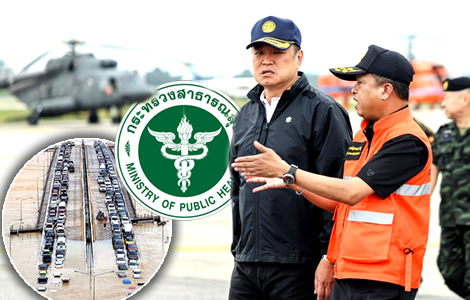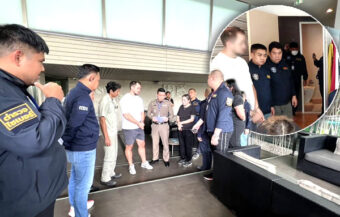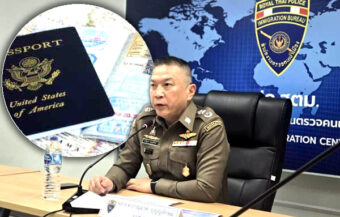Ebbing waters in Hat Yai reveal dead bodies as catastrophic floods devastate southern Thailand, triggering widespread public anger at the government. 110 deaths have so far been confirmed in the city, with fears that far higher numbers may have perished in the city.
Public anger in Hat Yai, Songkhla and across the South at Prime Minister Anutin Charnvirakul’s government is rising fast. Fears are growing that the death toll from the catastrophe may exceed all previous estimates. On Thursday, as waters receded in Hat Yai, rescuers and officials began discovering bodies. National Police Commissioner General Kittirat Phanphet confirmed 110 deaths in the city alone, though many flooded areas had yet to be reached. On Friday night, a Ministry of Public Health statement triggered panic, revealing 450 body bags were being sent to Hat Yai, with 1,500 more due on Saturday. The unfolding disaster across southern Thailand and Hat Yai has raised urgent questions about the government’s competence and response.

Rising fears have emerged over catastrophic flooding in Songkhla, particularly in Hat Yai. On Friday, Prime Minister Anutin Charnvirakul returned to the city after reports indicated a higher death toll.
Authorities have described the flooding as unprecedented, with rapid water rises and widespread damage to homes and infrastructure. Over the past 24 hours, public anger has intensified, primarily due to misinformation and false assurances issued before the disaster.
Local officials, especially the Bhumjaithai Party-supported mayor, Mr. Narongporn Na Phatthalung, were singled out for prior claims that the floodwaters would recede quickly.
Public anger mounts as misinformation and mayoral assurances worsen flooding crisis in Hat Yai
Despite growing calls for resignation, the mayor has resisted stepping down. On Friday evening, he was hugged by the Prime Minister upon arrival in Hat Yai. The scale of the disaster became clear on Thursday when floodwaters began to recede.
Significantly, the lowering water levels revealed numerous bodies across affected areas, bringing home the severity of the crisis. Meanwhile, National Police Chief General Kittirat Phanphet on Friday confirmed 110 deaths in Hat Yai alone, with the government estimating 145 fatalities across the southern provinces.
The Ministry of Public Health reported that 450 body bags had been delivered to Hat Yai on Friday, with another 1,500 expected on Saturday. Initially, the ministry posted these details online, but later deleted the message.
Netizens captured the images, prompting speculation about the true number of casualties. Mr. Siripong Angkasakulkiat, spokesman for the Forward Flood Emergency Operations Centre, confirmed the cumulative southern death toll at 145, including the 110 deaths in Hat Yai.
Officials face scrutiny after evacuation claims and minister leaves press conference amid criticism
Government communications have come under intense scrutiny. Mr. Siripong stated that evacuation orders had been issued, but he suggested delays occurred because some residents refused to leave. His remarks drew criticism for shifting responsibility away from officials.
Pradorn Prisananantaku, Minister to the Prime Minister’s Office and Director of the Centre for Emergency Situation Resolution (CERES), faced heavy questioning regarding crisis management. During a press conference, he muted his microphone and left after brief remarks, leaving multiple questions unanswered.
Opposition figures criticised the minister’s actions. Phakamon Nunan, MP for the People’s Party, described his departure as a retreat from responsibility. She emphasised that southern provinces remained in crisis and called for accurate reporting and expedited solutions.
Senior media journalist Suthichai Yoon noted that officials should maintain communication during emergencies. He observed that leaving questions unanswered undermined public confidence and contrasted sharply with Pradorn’s previous reputation as Deputy Speaker, where he was praised for decisive parliamentary leadership.
Special operations deployed to Hat Yai District 8 to recover bodies and secure flooded areas under strict law
Police confirmed that special operations teams were deployed to Hat Yai District 8. These teams were tasked with clearing debris, ensuring public safety, and recovering bodies. Authorities emphasised that all operations would follow legal procedures.
General Kittirat detailed three categories of fatalities: patients transported from Songklanagarind Hospital, unidentified bodies, and those recovered from flooded areas. Hospital deaths were classified as natural. Twenty unidentified bodies are undergoing DNA testing, expected to be completed by Saturday.
Three teams of doctors and OBEC officials were assigned, with each team processing up to 20 cases daily. Procedures were modelled on prior national disasters, including the Suphan Buri fireworks factory explosion and the school bus fire.
Aircraft from the Police Aviation Division supported evacuation and forensic teams, while local foundations provided additional resources. Authorities restricted unauthorised entry to District 8, ensuring operations proceeded in an orderly manner.
Police emphasise law enforcement and life preservation as recovery continues in Hat Yai
Authorities stressed that theft from flooded properties would be investigated if complaints were filed. Police emphasised the importance of public cooperation while prioritising life preservation. Prime Minister Anutin returned to Hat Yai on Friday to oversee relief efforts.
He visited affected districts alongside the mayor, coordinating evacuation, supply distribution, and recovery operations. Floodwaters in some areas exceeded head height, complicating access and prolonging rescue operations.
Food distribution was expedited in alleys where water levels were waist-high or higher. Aircraft delivered supplies to areas unreachable by road. Dried food packages were distributed to families in flooded zones.
The Ministry of Public Health confirmed 400 body bags were already delivered, with 1,500 more en route. Officials deleted the initial social media post, sparking public questions regarding the scale of fatalities.
Coordinated recovery and emergency teams work to clear debris and distribute supplies efficiently
Police Chief Kittirat confirmed ongoing recovery operations, with high-risk areas secured and debris cleared. All personnel were instructed to follow standard operating procedures. Officials acknowledged some residents had refused evacuation despite warnings.
They noted that delays in rescue operations occurred partly because residents remained in high-risk areas, though critics argued official warnings and assistance were insufficient.
Coordination between police, medical teams, and local volunteers remained active. Emergency personnel oversaw the removal of bodies, clearance of roads, and distribution of essential supplies. Aircraft were used to reach districts with impassable roads.
Recovery procedures followed established forensic protocols, and local foundations supplemented government efforts.
Law enforcement and oversight maintained as authorities continue disaster response in South
Authorities emphasised strict adherence to law during ongoing operations. Recovery in District 8 included clearing debris, securing high-risk zones, and preventing unauthorised entry. Hospital deaths were processed according to natural death protocols, and DNA testing continued for unidentified bodies. Families were notified once identification was complete.
Officials stressed public cooperation during the crisis. Law enforcement measures remained in effect, and authorities reiterated that preservation of life was the highest priority. Prime Minister Anutin continued oversight of all operations, coordinating closely with the mayor and local officials. Evacuation, relief, and recovery remained the focus as floodwaters continued to affect many districts.
Recovery teams prioritised clearing blocked roads, distributing food, and restoring essential services. Aircraft supplemented ground transport to reach isolated areas. Hospitals received additional resources for medical care and forensic procedures.
Confirmed fatalities remain at 110 in Hat Yai and 145 across southern provinces, with the distinct possibility of additional deaths as operations continue. Indeed, the emerging story is one of catastrophe and disaster, which the government is trying to manage. Fears are certainly growing.
Food distribution and evacuation continue alongside recovery and identification efforts
Food and emergency supply distribution continued under supervision, and vulnerable populations were prioritised for evacuation and assistance. Additionally, local authorities coordinated with hospitals to manage deceased and unidentified bodies. Meanwhile, DNA testing proceeds, and families were notified upon confirmation.
Law enforcement and public safety measures remained central to ongoing operations. Furthermore, recovery efforts are focused on debris clearance, body recovery and securing high-risk areas. Coordination among government agencies, police, and volunteers, therefore, is a grim process. They are toiling in a city where locals are shocked, still in need of assistance and angry at what has happened.
Prime Minister Anutin and local officials maintained on-site oversight, and evacuation, relief, and recovery operations continued as the primary focus. Moreover, emergency teams maintained a visible presence in the most affected districts.
Food and supply distribution continued, using both aircraft and ground transport to reach all affected areas. At the same time, vulnerable residents were prioritised, and evacuation operations remained active.
Authorities continue coordination with hospitals to process deceased and unidentified in recovery mode
Authorities continued coordinating with hospitals to manage the deceased and unidentified bodies.
Law enforcement and safety compliance remained central to operations. Recovery operations focused on clearing flooded areas, distributing aid, and securing high-risk zones.
33 deaths and still rising as southern floods threaten to overwhelm the government’s dithered response
Rising ‘Water of Death’ sees Songkhla and Hat Yai facing worst flooding in 300 years, say some observers
Aircraft deliveries complemented ground-based distribution. Coordination among agencies, emergency teams, and volunteers continued to ensure relief operations progressed efficiently.
Prime Minister Anutin and local officials continued oversight of all operations. Recovery, evacuation, and relief work remained the top priorities. Emergency teams ensured continuous monitoring and aid delivery in all affected districts.
Nonetheless, at some stage, the scale of this disaster must be assessed. Presently, the government and local services, including the army and police, are going through the motions. It has been reported that the Royal Thai Army may take on responsibility for the recovery operation. However, the fear is that the city of Hat Yai has been hit by an unprecedented disaster which has yet to reveal itself.
Join the Thai News forum, follow Thai Examiner on Facebook here
Receive all our stories as they come out on Telegram here
Follow Thai Examiner here
Further reading:
People’s Party on campaign but on guard against potential legal complaints to oversight agencies
Wealthy young People’s Party leader aims to create a technology-driven and efficient welfare state
Inward immigration may ultimately be the only thing that can halt Thailand’s fated economic decline
Thailand’s days of GDP growth in excess of 5% may be a thing of the past as it has grown too old
Cabinet in pension move as the number of working Thais to over 60s is set to half in 20 years
Thailand’s new move to boost the birth rate and fight the negative impact of an ageing population


















